How is your Android device benchmark?
AnTuTu is one of the most popular benchmark applications for Android devices. AnTuTu will check the parts of your device and specify the overall score.
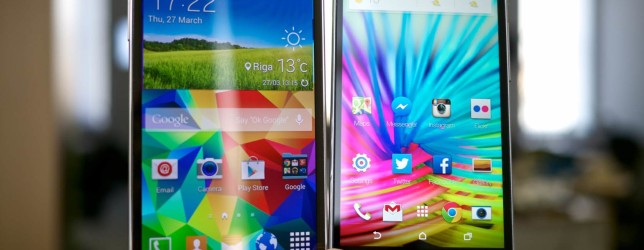
If your Android device doesn't have AnTuTu yet, you can download the app to your device and install it here.
1. Overview
Like other benchmark applications, AnTuTu gives you an overview of your device as well as the score of each item that the application has tested. The overview score is created by adding each item score together.
Score is just a useful tool for you to compare with other devices. For example, if your device score is 1000, and the score of another device is 2000, it means your device is twice as fast as the other device.
Partial test scores are used to compare the relative performance between different parts of the device, such as to compare the speed of storage on your phone with another phone.

2. UX (User Experience)
There are several reasons that User Experience (UX) scores are ranked first in this list. This score is considered an overview score representing the 'user experience' of the device in practice. It is an evaluation and feel of a user's device performance without deep digging into other benchmark standards or relying too much on the overall score.
UX is divided into 2 small scores: Multitask and Runtime. The Multitask score represents the multitasking level of the device, so a multi-core CPU will support this score. The score of the Great Runtime for the application runtime on Dalvik's Android compiler.
If you dig into the Android developer options and switch to the ART test run time, your performance score will improve. This is because the new ART runtime works better than the runtime on Dalvik compiler, and this score is real performance.
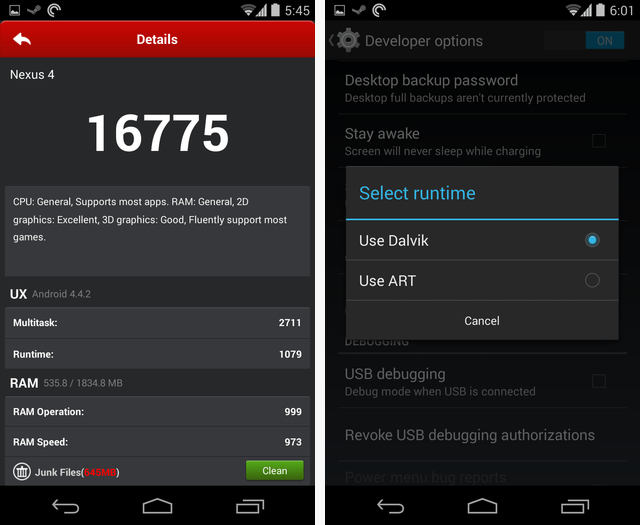
3. RAM
Your device uses Radom Access Memory (RAM) that acts as memory, while Flash Storage or internal memory is used for long-term storage. RAM can write and read data faster, so your device performance will be faster. RAM is used 'permanently' on your device.
AnTuTu divides the score of RAM into RAM Operation and RAM Speed. There is no specific difference between RAM Operation and RAM Speed. AnTuTu also has no documents explaining what these scores are. The overall score will show how fast RAM performance is.

4. CPU
Your device's central processing unit (CPU) performs processing of super-fast programs and data. The faster the CPU is, the faster applications run, so everything on your device will work faster. Of course when it comes to a certain level, how fast the CPU is, it doesn't affect performance much.
In addition, a fast CPU will support devices running high-demand applications, such as high-end games.
AnTuTu divides CPU benchmark into 2 small scores: CPU interconnect and CPU float-point. If you are a regular user, you do not need to care about the difference between CPU interconnect and CPU float-point.
If you really want to know the difference between CPU interconnect and float-point CPUs, there are two different integer types in programming: interger and floating point.
Interger only contains integral or integer values. In other words, an interger (integer) can be 2, or 4 or 34343422352349 but cannot be 3.14.
A floating point value can be decimal digits. For example, a floating point value can be 3.14 or 53.2342, 6. 342352236236236 or even 1.
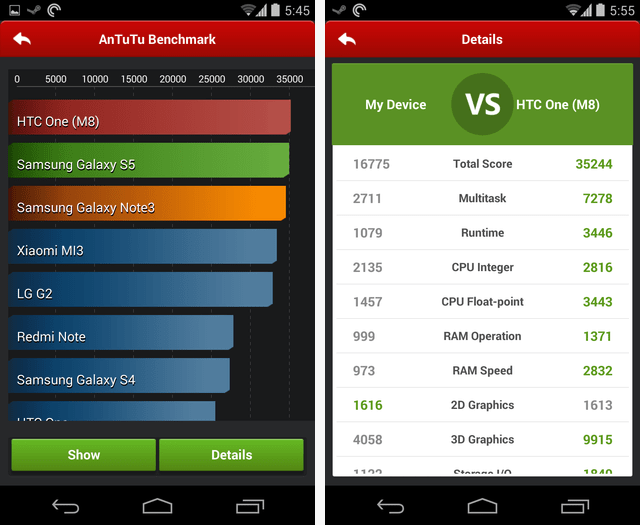
5. GPU
GPU stands for Graphics Processing Unit, a dedicated microprocessor that accepts acceleration and graphics processing for CPU central processors. When you play any game, your GPU will 'kick' on the gear icon and render 3D graphics or accelerate 2D graphics.
Many animation interfaces and other effects also use GPU. GPUs are optimized for graphics operations - GPUs can perform but time-consuming processes and use multiple batteries.
CPU is not used for all number-crunching on your device - GPU is used in graphics number-crunching.
This benchmark is divided into 2 sub-sections, 2D graphics and 3D graphics. You will see AnTuTu perform both test 2D and 3D tests during benchmarking. 2D graphics are used when you play the classic Angry Bird to move birds and some other elements on the screen.
3D graphics are used when you play Angry Bird Go! To render 3D scenes.
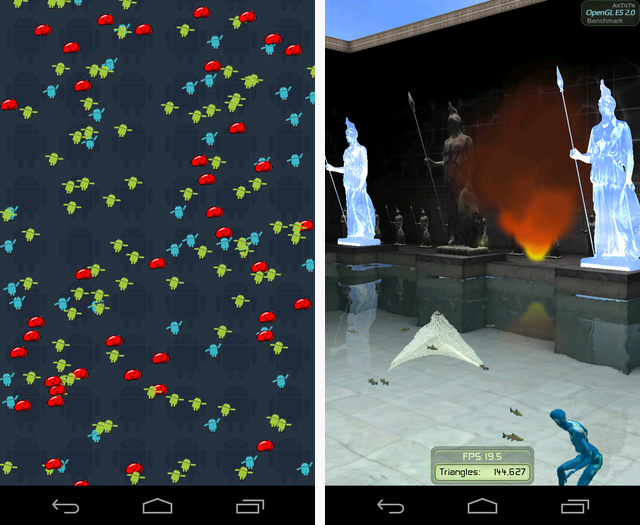
6. IO
Input / Output score - IO (input / output) reflects the device's internal memory speed, such as Flash Memory or internal memory. This is where your apps, settings, files, etc. are stored for a long time. Your device regularly loads data here and stores data into internal memory.
The faster internal memory means that applications will load faster, files will be stored faster and you will find that the interface is less problematic when storing an application's data or loading data. material on background.
AnTuTu displays both benchmark scores of Storage I / O (input / output memory) and Database I / O (input / output data).
Storage I / O represents the internal memory input / output speed on your device. Database I / O represents the speed when reading and writing to the database.
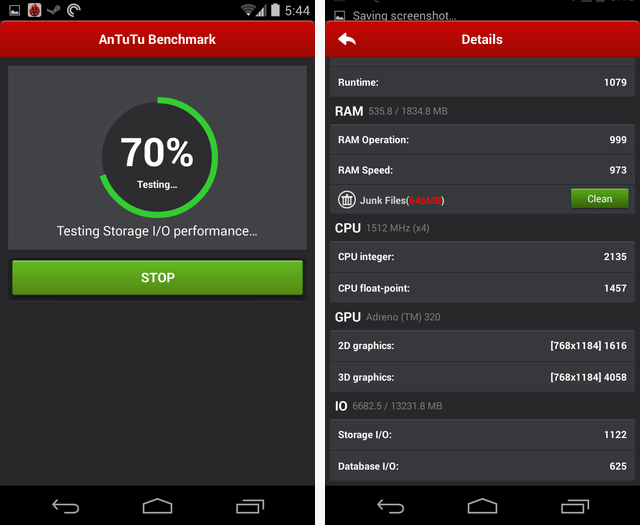
Refer to some of the following articles:
- The difference between jailbreak, root and unlock
- 3 signs that your Android device is attacked by a virus
- How to transfer all data from an old Android phone to a new phone?
Wish you have moments of fun!
You should read it
- AnTuTu announces the top 10 Android smartphones with the highest benchmark scores in March 2020
- The famous benchmark app AnTuTu was suddenly removed from the Play Store
- AnTuTu released version 7.2.6 update to prevent benchmark fraud on smartphones
- AnTuTu announced the 'best value for money' smartphone model in February 2020
- The strongest Android 10 smartphone chart as of April 2019
- AnTuTu explains why Google deleted it from the Play Store
- AnTuTu announces the best processors 2020 on Android
- 5 free apps that allow evaluation of Android devices
May be interested
- How to Access Android Device from Computer
 this article shows you how to access and interact with android files from a windows computer. the simplest way to do this is to connect your android device to your computer using a usb charging cord, but you can also use bluetooth to send and receive files between your android device and computer. if you want to adjust your android device while you're away, you can use a free app and computer program called airdroid.
this article shows you how to access and interact with android files from a windows computer. the simplest way to do this is to connect your android device to your computer using a usb charging cord, but you can also use bluetooth to send and receive files between your android device and computer. if you want to adjust your android device while you're away, you can use a free app and computer program called airdroid. - Android devices will exceed 1 billion mark this year
 the number of devices running android os is currently increasing rapidly and it is likely that in 2014 this will exceed the 1 billion mark, at least according to data from market research firm gartner.
the number of devices running android os is currently increasing rapidly and it is likely that in 2014 this will exceed the 1 billion mark, at least according to data from market research firm gartner. - Tips for Controlling Android Devices from Another Android Device
 this is an article that shows you how to use your android phone or tablet to control another android device. you can use the free version of teamviewer for android to do this, or use the remodroid app...
this is an article that shows you how to use your android phone or tablet to control another android device. you can use the free version of teamviewer for android to do this, or use the remodroid app... - Rescue an Android device that is faulty and 'dead'
 when an android device has a fatal error or cannot even boot, the safe and restore device in its original state will help you save your own.
when an android device has a fatal error or cannot even boot, the safe and restore device in its original state will help you save your own. - AnTuTu released version 7.2.6 update to prevent benchmark fraud on smartphones
 in order to prevent some smartphone manufacturers from using some fraudulent tricks to get higher benchmark scores than competitors to entice users to buy their products, antutu has released a counter important date for their performance grading software.
in order to prevent some smartphone manufacturers from using some fraudulent tricks to get higher benchmark scores than competitors to entice users to buy their products, antutu has released a counter important date for their performance grading software. - How to enter Recovery mode on Android phones
 if you are using a device running android operating system and feel that the machine generates many errors by accidentally sticking the data containing malicious code, virus, ... disrupting the process of using the device as well as making the device if your device becomes slower, it is necessary to enter recovery mode to improve the performance of your device.
if you are using a device running android operating system and feel that the machine generates many errors by accidentally sticking the data containing malicious code, virus, ... disrupting the process of using the device as well as making the device if your device becomes slower, it is necessary to enter recovery mode to improve the performance of your device. - Instructions to root Android easily and quickly
 after rooting your android device, you have full access to the system and can run many types of applications that require root access. these applications can disable bloatware, allow application control, enable connections and many other great things.
after rooting your android device, you have full access to the system and can run many types of applications that require root access. these applications can disable bloatware, allow application control, enable connections and many other great things. - How to fix Android device not connecting to the computer
 is your android device unable to connect to your computer? there are many causes of this problem, including improper connection mode or no standard driver. just the slightest problem can prevent your computer from recognizing the device.
is your android device unable to connect to your computer? there are many causes of this problem, including improper connection mode or no standard driver. just the slightest problem can prevent your computer from recognizing the device. - Unlock the Android device screen by tapping the screen twice
 the usual way we often use to unlock the android device screen is to press the power button, or on some other android device, users can use the command to speak, requesting to unlock the android device.
the usual way we often use to unlock the android device screen is to press the power button, or on some other android device, users can use the command to speak, requesting to unlock the android device. - The best games to benchmark new gaming PCs
 before jumping into your favorite games after building a new gaming pc, benchmark the machine with some demanding games. this list includes the best games to benchmark new gaming pcs.
before jumping into your favorite games after building a new gaming pc, benchmark the machine with some demanding games. this list includes the best games to benchmark new gaming pcs.










 4 ways to fix DF-DLA-15 errors during the download process on Play Store
4 ways to fix DF-DLA-15 errors during the download process on Play Store How to create trash for Android with Dumpster
How to create trash for Android with Dumpster How to view saved Wifi passwords on Android?
How to view saved Wifi passwords on Android? 2 steps to test Zenfone 2 before buying the device
2 steps to test Zenfone 2 before buying the device When detecting someone using Wifi temple, do the following to prevent
When detecting someone using Wifi temple, do the following to prevent